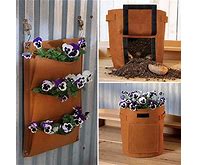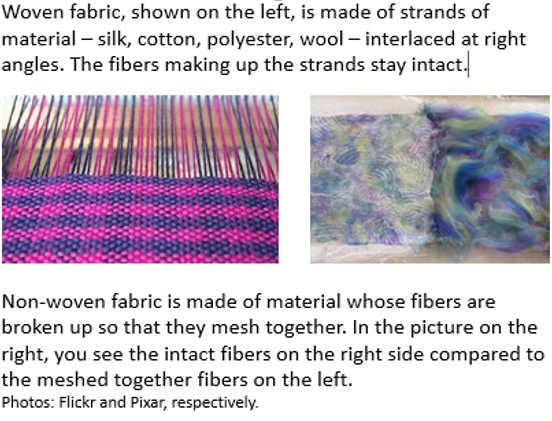Growing A Garden in a Cloth Bag
Lightweight portability, small-space friendly, raised bed alternative: three reasons to try cloth grow bags. Many people are turning to these fabric containers for use as raised bed planters. It is essentially a form of container gardening where the emphasis is on the container, not what goes in it.
People can get pretty creative with planters; we’ve seen drawers, pots, and even boots used. While those may have their artistic merit, there are a number of benefits to using cloth grow bags, despite their utilitarian appearance. In this article, we’ll look at the what, why, and how of cloth grow bags.
Cloth Grow Bags 101
The bags are generally round in shape and come in varying sizes, usually from 5 to 50 gallons. But they can be shallow and wide, tall and deep, or rectangular in shape.

Some are decorated with stripes, belts, or zippers but most are plain and simple. Colors are generally limited to black, brown, tan, green or blue.
Woven vs. Non-woven

Burlap: The Woven
Burlap is traditionally made from jute, hemp, or flax plants and can have a coarse or fine weave. It’s used for clothing, rug backing, storage, and homeware. Of course, you can now find burlap made from synthetic materials, too.
Felt: The Non-Woven
A fabric whose history stretches back into ancient times, felt is traditionally made from wool or fur. Fibers are broken up so they blend into each other, forming a dense, durable layer of material. If you want to be a Super DIYer, you can start your cloth bag garden by making your own felt and then making your own bags.
Or just shop Amazon.
Landscaping Fabric as Garden Container
Sure, you could use landscaping fabric as some sites suggest, but consider that it’s commonly made from polypropylene, a commonly found polymer to which some people are allergic. The material is treated with chemicals to prevent weed growth and may also be treated with a UV protector to slow the evaporation process. What’s in the container goes into the soil, goes into the food.
If you’re fine with that, check out the vid tutorial from Grow Your Heirlooms to make your own grow bags from landscaping fabric.
If you’re not okay with that, you’ll look for the phrase “non-woven
fabric” in your search and then look closer still to see what that fabric is.
But, you may ask, why would I want floppy fabric containers for my garden?
The Pros and Cons of Cloth Grow Bags
Actually, the bags hold their shape nicely once filled with
soil. But, you may ask, why use a cloth bag instead of a nice ceramic, wood, or
plastic container? Every gardening method has its good points and its challenges
that may require creative thinking. Cloth bags have more of the former.
The Pros
Roots grow properly
When a root grows out to the wall of a traditional
container, it curves back in the other direction, looking for more space. The
roots keep growing, following the borders of the container. Without
intervention, the plant ends up sitting on a nest of tangled roots. The result
is stunted growth and probably the early demise of the plant. None of that
here!
Air-pruning simplified
In a cloth grow bag, when a root reaches the wall of its
confinement, it’s exposed to air which burns it off. This causes the plant to
send out new feeder roots that branch out to gather more nutrients and water.
The result is a big healthy and happy plant.
Drainage
The millions of teeny holes in the material prevents overwatering plants since the water quickly evaporates.
Aeration
The cloth slows but doesn’t keep air from getting into the
soil, in this way the roots don’t suffocate and mildew won’t grow.
Healthy soil microbes
Increased airflow from a nearly 360° radius means healthier little
organisms contentedly doing their plant-building thing in the soil.
It’s Not Plastic
Another way to eliminate plastic from your living and
growing space. Bisphenol A (BPA) is one of the many chemicals found in plastic.
When found to wreak havoc with the hormone system, manufacturers were quick to
reconfigure their formulas so they could loudly proclaim that their products
are BPA free.
Unfortunately, BPA’s relatives – BPB, BPF, and BPS – have been found to have the same estrogenic effect in laboratory studies as BPA. Products that are BPA-free often contain BPB, -F, and -S.
Estrogenic effect means the body responds to the chemical as if it were the hormone estrogen, affecting not just the reproductive system but also the heart, brain, hair, skin, muscles, and other body systems. The results are a slew of undesirable conditions.
If you’re not ready to go as plastic-free as is reasonably possible in our plastic-heavy society, LiveStrong has a great article on which plastics are which.
Cloth Bags Are Reusable
When you’ve transplanted your seedlings or harvested your crop, the bag can be emptied, (air) dried, and any excess dirt brushed or beaten out. They can then be sterilized, rinsed very well, and thoroughly dried before being put back into service.
Easy Storage
If you’re only interested in growing plants during a part of the year, cloth bags can be folded compactly and stored out of the way on a shelf, bin, or drawer.
Portability
Of course you could go the ceramic, metal, or wood route,
each with their respective pluses and minuses. They are also reusable. But they
can be heavy, you’re moving their weight along with the soil and plant. Cloth
bags can be easily moved from one location to another. And most have handles, making
it super easy to move them as needed.
Huge Time and Energy Saver
No tilling, digging, aerating, or other soil preparation is needed. Planting is a breeze!
Indeed, many are the reasons to grow your container garden
in cloth bags. But read on for a few challenges to this method.

The Cons
… are relatively few and most come with sensibly easy
remedies.
Soil Dries Out Quickly
With all that air flowing in and around the plant, naturally
the rate of evaporation will be greater than if the plant is sitting in a
ceramic or plastic container.
Self-watering systems are an
obvious fix for the increased watering demand. Self waters can be as simple as
an upended bottle with a perforated stake or a more involved drip irrigation
system.
Wicking is another
labor-freeing route. Place the bags in a large, shallow container of water; no
more than 1 – 2 inches deep. The folks at Northern Homestead favor using a
kiddie pool, others use plastic storage bins.
Someone suggested using Styrofoam crates; the material is
banned in my County and there are proposals to take the ban statewide in Maryland.
Mulch added to the top of the grow bag helps the soil hold onto its water.
Soil should include moisture-preserving compounds like compost, vermiculite, and moss in the soil.
Can’t Get a Good Soak
Soil in a porous container is not going to hold a large amount of water for any length of time. It’s that evaporation thing again. There is a simple alternative to regularly hauling out buckets of water or the hose:
The hydroponic ebb-and-flow method is a balanced way of keeping roots and soil watered to the right degree.
Water Management
Whatever watering method you use, you’ll need to monitor the
water level throughout the week. Besides ensuring the proper supply of water,
in the summer months you’ll also want to ensure that the water doesn’t become a
mosquito nursery.
Keeping Water Mosquito-Free
As discussed in Chapter 5 of the Basement Garden series, companion planting is a traditional pest repellent practice. But researchers in India found that components in basil (Ocimum basilicum) are toxic to mosquito eggs.
Online are a lot of lists of mosquito-repellant plants (actually it’s pretty much the same list, repeated across many sites). But the articles are mostly geared towards keeping people and pets bite-free. Mosquitos will steer clear of strong scents like cinnamon, lavender, peppermint, and thyme. So the prevailing wisdom is to crush leaves or flowers and apply directly to skin. Keeping the water of a garden container bug-free has its own considerations.
Food Plant v Decorative Plant
You may come across comments in product Q&As where people report using things like Mosquito Dunks® in their lily pond without any bad effect on the plant. In fact, many mosquito repellent products say they are safe to use around children and pets.
Mosquito Dunks® contain naturally occurring Bacillus thuringiensis subspecies israelensis. The Summit brand of dunks were approved by the National Organic Program for use with organic plants.
Does this mean dunks are safe for food-growing use?
Probably not. The NOP, run by the U.S. Environmental Protection Agency (EPA), regulates the organic growing process. It does not address food safety so it may be the prudent course to leave the dunks for non-food water bodies.
You could always apply a repellent like Mosquito Beater pellets around the outside of the water holder. It contains the essential oils of many of the plants listed above, along with heavy-hitters (smellers?) like citronella, cedar, geranium, and garlic. Sprinkle around pools, camps, or any outdoor space to discourage mosquitos.
Selecting the Bags
While some gardeners will cheerfully use cloth bags from any
source, more cautious shoppers will consider the material and manufacturing. As with any type of container gardening, consider
a few questions to ask:
- Is the bag treated with an anti-stain or water repellant formula?
- Is the bag dyed with food-friendly paints or inks?
- What did the (repurposed) bags contain?
- Exactly what are the recycled materials used to make this bag?
- Am I sure I can sterilize the bag sufficiently to use with food?
Care of the Bags
You’ll want to empty the bags regularly to freshen the soil and inspect the bag for mildew, mites, and wear. With proper care, they should take you through many years of harvests.
Between use, they should be cleaned thoroughly. One gardening website suggested beating off excess dirt before tossing the bags into machines at a laundromat if you have more than one or two to wash. The potential of damaging a public resource doesn’t sound nice. To me. Get your exercise in, sterilize and wash your bags manually. Or use your own washer.
Growing in a Cloth Bag
- Select a location – will it be on the ground, in
a container, suspended, or on a stand? - Place soil into the bag.
- Add plant or seeds.
- Water.
- Feed.
- Monitor.
- Harvest.
A Down-to-Earth (Raised) Garden
Using cloth grow bags offers convenience in gardening, sparing your back and knees from digging and mussing with large plots of land. They offer an easy do-over if you happen to change your mind about where you want your garden situated. With a traditional garden , you can’t undig up the ground (yes, I know it’s not a real word).
Carry your garden in for the winter and back out for the spring. Raised garden, container garden, vertical garden – cloth grow bags will enhance whichever garden you choose to grow. Are you a cloth grow bag fan? Perhaps in the near future?